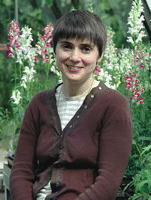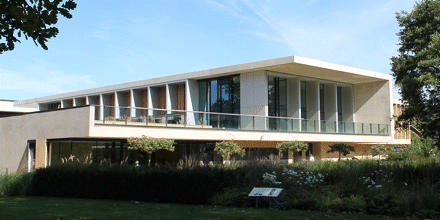An Interview With Ottoline Leyser
Posted by Eva Amsen, on 25 October 2011
(This interview originally appeared in Development.)
The Sainsbury Laboratory at the University of Cambridge is a new research institute that aims to achieve an integrated understanding of plant development. Its Associate Director is the new plant Editor of Development, Ottoline Leyser, who is also Professor of Plant Development at the University of Cambridge. We recently caught up with Professor Leyser and asked her about the Sainsbury Laboratory and about her own research interests.
 When did you first become interested in plant development?
When did you first become interested in plant development?
To me, plant development has always been much more interesting than animal development, because of its plasticity. In plants, the body plan is incredibly flexible: one genotype can occupy an extraordinary range of phenotype space. I’ve always thought that was just amazing.
I did my undergraduate degree here in Cambridge, in the Genetics Department, not in plant science. We had this absolutely fantastic interdepartmental development course that was taught by John Gurdon, Peter Lawrence and many other wonderful people. It was very striking, the contrast between what was happening in animal development, which was being transformed by Drosophila genetics, by Christiane Nüsslein-Volhard, Eric Wieschaus and others, and what was happening in plants: despite the long tradition of genetics in plants, developmental genetics somehow hadn’t really taken off. But in the final year of my undergraduate degree, there were the first hints of Arabidopsis as a model organism, driven at least in part by Elliot Meyerowitz, who is now the inaugural director here at the Sainsbury Laboratory. So, there was suddenly a very exciting opportunity to push things ahead in plant development using developmental genetics. I started looking for a PhD position in an Arabidopsis lab and, fortunately for me, Ian Furner had just arrived back from the USA clutching some Arabidopsis seed in a tube, so I stayed in Cambridge and did my PhD with him, studying meristem mutants in Arabidopsis.
What are you working on at the moment?
I’m working on the role of plant hormones in integration of the endogenous and environmental signals that control the plant body plan. We’re looking principally at shoot branching control and are trying to understand how every individual axillary bud on the plant makes a decision about whether to activate or not, depending on multiple inputs. It’s really a question of signal integration.
You’ve recently moved your lab from York to Cambridge to set up the new Sainsbury Laboratory. How did the lab move go?
It’s still an ongoing process. We’re pioneers down here, who have had to deal with a very fabulous but nonetheless brand new and, at the time, unfinished building. But now that the first results from experiments carried out in the new lab are coming in it’s very exciting. Meanwhile, there’s still a core of people in York, partly because some people didn’t want to move and partly because we’re in the middle of a rather long-term ten-generation Arabidopsis experiment, which I didn’t want to move.

How and why was the Sainsbury Laboratory formed?
The Sainsbury Laboratory is funded by the Gatsby foundation, which is a charity of the Sainsbury family. They have a series of charities that reflect the interests of members of the family and plant science is a particular interest of David Sainsbury. Within plant science, his main focus has been on plant pathology and plant developmental biology. There’s an existing Sainsbury Laboratory in Norwich that focuses on plant pathology, so we represent the other side of his interests.
I think those interests reflect a humanitarian side, because plant pathology and plant developmental biology are at the root of crop productivity. Everybody is increasingly aware of the requirements for sustainable and secure food supplies. You can very plausibly make an argument that inadequate food supply kills more people than cancer, but the amount of funding going into plant science research is quite low compared with the funding that cancer research receives. One of the things this institute does is put a flag in the ground for the extraordinary importance of plant sciences. It’s a very iconic building in a very public location in the Botanic Gardens at Cambridge University and this public, visible location seems to say that plant biology is really important, which it is.
When was the building officially opened?
It was officially opened at the end of April, by her majesty the Queen and the Duke of Edinburgh, who was the Chancellor of Cambridge University until June 2011. They were here for almost an hour and it was exciting. They were surprisingly engaged with the experiments. We showed them a number of examples of the sort of work we’re doing and they asked sensible questions. I think most of us felt that it’s excellent for plant science to have something this high profile going on.
How many labs will the institute host?
We’re planning to have around 12 group leaders, each with a group size of about 10 people. We’ll have group size limits – we’re not going for enormous expanding labs, because we want to create a collaborative, integrated research environment. If you have a huge group it tends to fragment things. So, the building is designed for about 120 scientists, with an additional 30 or so support staff.
What will be the main focus of the research at the Sainsbury Laboratory?
The institute is focused on plant developmental biology, with a particular interest in computational modelling. I think there’s a feeling that development in general, and certainly plant development, has got to the point at which it needs rigorous computational models to allow us to understand the regulatory networks that underlie development. Once you’ve got a sufficient understanding of the components in a system, and know that there is a lot of feedback regulation, it becomes incredibly difficult to make sensible predictive experimental plans without a computational model. We’re hoping to set up something here that, from the beginning, stimulates integration of computational approaches and wet experiments.
Are there any questions in particular that computational modelling has already answered in plants, or will answer soon?
There are lots of very good examples of computational modelling providing insights that would’ve been hard to get from the sort of classical, ‘back-of-an-envelope’ approach that people used before. There are several good models of phylotactic patterning, which is the system that produces the patterns in which leaves emerge from the meristem, that have been very helpful. There are also very good models of the circadian clock. Computational modelling is now a widely adopted approach in systems that are sufficiently well understood.
You’re also the new plant editor of Development. What role does the journal play in the field of plant development?
I think Development holds a very special place in the plant community. The developmental biology community has been more welcoming to plant science than some other communities. One reason for this is that development has quite unifying underlying concepts, which you can transfer very easily between systems. This means that you can have interesting and engaged discussions with people who work on completely different models – both in terms of organism and developmental system – because everybody understands terms such as ‘determination’ or ‘commitment’. So Development is the place to go for plant biologists whose work contributes to the understanding of universal developmental mechanisms in a way that is interesting to the whole developmental biology community.
Is there any particular type of plant research that you’d like to see published inDevelopment?
I think that the key qualities of a paper in Development relate to fundamental issues of developmental mechanisms, and understanding the solutions to basic problems in development. That’s what I’d like to maintain. I’m less interested in descriptive studies of the functions of individual genes, and more interested in analytical studies of regulatory processes that explain the emergence of higher order properties in a developmental system. That’s the key issue: to understand such genotype-phenotype connectivity.
What do you do when you’re not doing research?
That’s actually quite an interesting question at this phase in my life, because until now I’ve always said “spend time with my family”, but one thing that made this move to Cambridge possible, apart from the tremendous excitement of setting up a new institute, was the fact that my youngest child has just left home to start university. But, we bought a house with a huge garden, so we’re going to be growing lots of fruit and vegetables.
You’ve written a book called ‘Mothers in Science’, about combining parenting with research. Is there any advice in particular that you would like to pass on to women who are thinking of combining research and family?
I put the book together because I was so frustrated with the prevailing pessimism that is endemic in science in general: that everything is so difficult and that anything you do that is a bit unusual immediately puts a black mark against you. Having children has somehow got itself included in that list of things that are impossible in a research career. And it’s just not true. If you look around there are many, many people who have successfully combined those things. I sometimes say that it’s perfectly possible to combine a career in science with children, because men have been doing it for centuries. I do think that is an important point. The part where you’re actually giving birth is a relatively short part of the process. The real issue is managing your flexibility of time for the next 20 years, and that’s not a gender issue – it’s a parent issue. It breaks your heart to see people who are excited about research and keen to pursue that as a career choosing other things because they think it’s going to be too difficult or that it’s going to restrict what else they can do. In many ways, academia is much more flexible as a career than a lot of other jobs.


 (2 votes)
(2 votes)
In a related sidenote, Lord Sainsbury is currently the Chancellor of the University of Cambridge. This piece went to press before the chancellor elections last week, and the interview occurred in a chancellor-less period after the Duke of Edinburgh had already stepped down from the position.